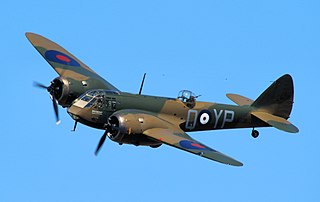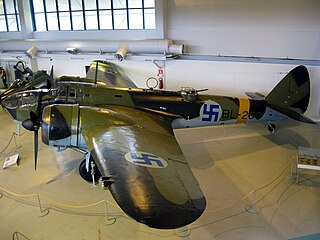
The Bristol Blenheim is a British light bomber designed and built by the Bristol Aeroplane Company, which was used extensively in the first two years of the Second World War, with examples still being used as trainers until the end of the war. Development began with the Type 142, a civil airliner, after a challenge from the newspaper proprietor Lord Rothermere to produce the fastest commercial aircraft in Europe. The Type 142 first flew in April 1935, and the Air Ministry, ordered a modified design as the Type 142M for the Royal Air Force (RAF) as a bomber.
Flying Regiment 4 was a bomber aircraft regiment of the Finnish Air Force. The regiment was formed on 1 January 1938 and was active during the Winter War, the Continuation War, and the Lapland War. During the Winter War, the unit flew 423 war missions, of which 22 were strategic and photo reconnaissance flights with its Bristol Blenheim Mk.Is. 18 aircraft and 21 crew members were lost.
No. 10 Squadron was a divebomber squadron of the Finnish Air Force in World War II. The squadron was part of Flying Regiment 1.
No. 12 Squadron, renamed No. 12 Reconnaissance Squadron was a reconnaissance squadron of the Finnish Air Force during World War II. The squadron was part of Flying Regiment 1.
No. 14 Squadron, later renamed No. 14 Reconnaissance Squadron, was a reconnaissance squadron of the Finnish Air Force during World War II. The squadron was part of Flying Regiment 1 during the Winter War and Flying Regiment 5 during the Continuation War.

No. 16 Squadron, renamed No. 16 Reconnaissance Squadron was a reconnaissance squadron of the Finnish Air Force during World War II. The squadron was part of Flying Regiment 1 during the Winter War and Flying Regiment 2 during the Continuation War.
No. 22 Squadron was a fighter squadron of the Finnish Air Force during World War II. The squadron was part of Flying Regiment 2. It was to be equipped with new Brewster Buffaloes and Hawker Hurricane Is, but only the first Flight saw action during the war. After the Winter War, the squadron was attached to the new Flying Regiment 3 and renamed as No. 32 Squadron.

No. 24 Squadron, renamed No. 24 Fighter Squadron was a fighter squadron of the Finnish Air Force during World War II. The squadron was part of Flying Regiment 2.
No. 26 Squadron, renamed No. 26 Fighter Squadron was a fighter squadron of the Finnish Air Force during World War II. The squadron was part of Flying Regiment 2 during the Winter War and Flying Regiment 3 during the Continuation War.

No. 28 Squadron, renamed No. 28 Fighter Squadron was a fighter squadron of the Finnish Air Force during World War II. The squadron was part of Flying Regiment 2.

No. 42 Squadron, renamed No. 42 Bomber Squadron was a long-range bomber squadron of the Finnish Air Force during World War II. It was established in 1940. The squadron participated in the Winter, Continuation and Lapland wars as part of Flying Regiment 4, and was the only regiment in the squadron that exclusively operated Bristol Blenheim bomber aircraft. The squadron was abolished in 1952.
No. 44 Squadron, renamed No. 44 Bomber Squadron, was a bomber squadron of the Finnish Air Force during World War II. The squadron was part of Flying Regiment 4.
No. 46 Squadron, renamed No. 46 Bomber Squadron was a bomber squadron of the Finnish Air Force during World War II. The squadron was part of Flying Regiment 4.
No. 30 Squadron, renamed No. 30 Fighter Squadron was a fighter squadron of the Finnish Air Force during World War II, which had been formed from the disbanded No. 10 Squadron. The No. 30 Sqn was part of Flying Regiment 5.
No. 32 Squadron, renamed No. 32 Fighter Squadron was a fighter squadron of the Finnish Air Force during World War II. The squadron was part of Flying Regiment 1. The squadron was formed from the disbanded No. 22 Squadron.
No. 34 Squadron, renamed No. 34 Fighter Squadron was a fighter squadron of the Finnish Air Force during World War II. The squadron was part of Flying Regiment 3.
No. 6 Squadron, renamed No. 6 Bomber Squadron was a maritime bomber squadron of the Finnish Air Force during World War II. The squadron was part of Flying Regiment 5.
No. 41 Squadron was a bomber unit of the Finnish Air Force formed in 1946 and based at Luonetjärvi. The squadron belonged to Flying Regiment 4. In 1951 the unit was renamed into No. 41 Squadron.
No. 36 Squadron was a maritime reconnaissance squadron of the Finnish Air Force during World War II. The unit was later reorganized into the No. 39 Squadron.
Flying Regiment 1 was a mixed regiment, incorporating both fighter, reconnaissance and communication squadrons, of the Finnish Air Force during World War II. The unit was disbanded in June 1941, but reformed from the Supplement Flying Regiment on May 3, 1942.
This page is based on this
Wikipedia article Text is available under the
CC BY-SA 4.0 license; additional terms may apply.
Images, videos and audio are available under their respective licenses.




